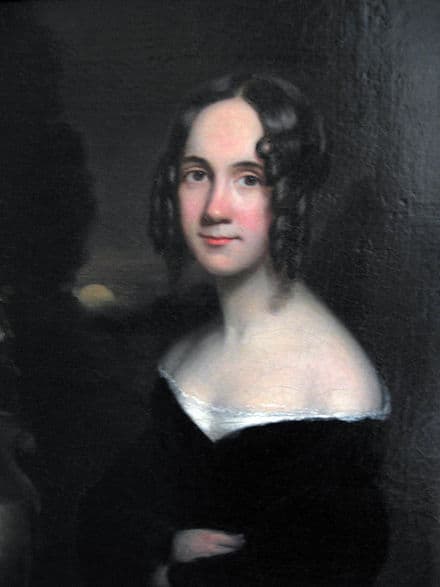What we’re really talking about is a wonderful day set aside on the fourth Thursday of November when no one diets. I mean, why else would they call it Thanksgiving?
—Erma Bombeck—
 How did Thanksgiving become a national holiday in America? The idea gained traction during the Civil War. It was championed by Sarah Josepha Hale (1788-1879), a writer and an editor of ladies’ magazines for many years. Encouraged in part by several editorials Hale had penned as well as a personal letter Hale wrote to him, President Abraham Lincoln issued the first of what would become an unbroken line of annual presidential Thanksgiving proclamations. Go here to read some excerpts from some of these. The tradition has lasted for more than 150 years, even to the present day.
How did Thanksgiving become a national holiday in America? The idea gained traction during the Civil War. It was championed by Sarah Josepha Hale (1788-1879), a writer and an editor of ladies’ magazines for many years. Encouraged in part by several editorials Hale had penned as well as a personal letter Hale wrote to him, President Abraham Lincoln issued the first of what would become an unbroken line of annual presidential Thanksgiving proclamations. Go here to read some excerpts from some of these. The tradition has lasted for more than 150 years, even to the present day.
You may have observed that, for some years past, there has been an increasing interest felt in our land to have the Thanksgiving held on the same day, in all the States; it now needs National recognition and authoritive fixation, only, to become permanently, an American custom and institution.
—Sarah Josepha Hale, in a letter to President Abraham Lincoln dated September 28, 1863—
A Federal Holiday Is Set
Of course, a presidential proclamation alone does not officially establish a federal holiday. Thanksgiving became an official national holiday in 1941, after three years of confusion and chaos. Confusion? Really? Over Thanksgiving? No kidding!
In 1789, President George Washington’s Proclamation for a Day of National Thanksgiving called for the observance to be held on November 26, the final Thursday in the month. With the first annual Thanksgiving Day recognized by President Lincoln in 1863 and with nearly all those that followed through 1938, Thanksgiving day was observed, again, on the last Thursday in November. Andrew Johnson’s proclamation in 1865 and Ulysses S. Grant’s proclamation in 1869 represent the only departures.
 In 1933, the same year that Franklin Roosevelt took office, November had five Thursdays. Placing Thanksgiving on the traditional final Thursday of the month would make for a short Christmas shopping season, and merchants feared this would translate into smaller profits. They asked the new president to designate November 23 as Thanksgiving Day to lengthen the gift-buying period—and hopefully to increase their income. Remember that at that time America was in the throes of the Great Depression. Roosevelt stuck with tradition that year and the next (see also here), but in 1939, the calendar was a carbon copy of the one for the year in which FDR had been inaugurated. That year he departed from tradition and designated “Thursday, the twenty-third of November, 1939, as a day of general thanksgiving.”
In 1933, the same year that Franklin Roosevelt took office, November had five Thursdays. Placing Thanksgiving on the traditional final Thursday of the month would make for a short Christmas shopping season, and merchants feared this would translate into smaller profits. They asked the new president to designate November 23 as Thanksgiving Day to lengthen the gift-buying period—and hopefully to increase their income. Remember that at that time America was in the throes of the Great Depression. Roosevelt stuck with tradition that year and the next (see also here), but in 1939, the calendar was a carbon copy of the one for the year in which FDR had been inaugurated. That year he departed from tradition and designated “Thursday, the twenty-third of November, 1939, as a day of general thanksgiving.”
An uproar ensued. Some businessmen were happy with the change, but many merchants who owned smaller shops worried customers might flock to the larger stores. Lengthening the Christmas shopping season, moreover, meant shortening the season for purchasing fall clothes, and this could have a potential negative effect for retailers as well. Calendars, which had been printed far in advance, no longer were accurate. And what about the football games that already had been scheduled? That issue, too, was a big deal!
Some states resisted the change while others went along with it, creating a situation for some extended families in which relatives wanting to get together lived in states observing the holiday a week apart (see here, here, and here). If you were fortunate enough to live in Texas or Colorado, you might could enjoy both the 23rd and the 30th as Thanksgiving Days, if your employer went along. These two states recognized both days!
Due to the confusion and upheaval, FDR’s chosen date for the holiday was given a special name: Franksgiving! The writers of the Jack Benny radio show—The Jell-O Program—had great fun with the idea of two Thanksgivings. Listen to Jack’s sidekick, Mary Livingstone, read a special poem about it on the episode that aired on November 19, 1939.1

The president departed from tradition in 1940 and 1941 as well. In 1940, even though November had just four Thursdays, Roosevelt proclaimed Thursday, November 21—the third Thursday—as Thanksgiving (also go here). In 1941 he did it again, declaring November 20 as the official day.
President Roosevelt issued his 1941 Thanksgiving Day Proclamation on November 8. Yet, even before then, Congress had taken the initiative to settle the confusion and frustration FDR’s departure from tradition had caused. The lawmakers’ efforts, however, would not take effect until 1942. On October 6, 1941, the US House of Representatives passed a joint resolution that officially established Thanksgiving as an annual holiday on the final Thursday of each November.
A few weeks later, in December, the Senate passed an amendment naming the fourth Thursday as the official day.
The House agreed, and the president signed the bill on December 26, 1941.

The fourth Thursday in November typically is the last Thursday of the month, but in two instances it is not—when it falls on the 22nd, and when it falls on the 23rd. This represented a small, but acceptable, departure from tradition. At last the issue had been settled. Accordingly, in 1942, President Roosevelt invited “the attention of the people to the joint resolution of Congress approved December 26, 1941, which designates the fourth Thursday in November of each year as Thanksgiving Day,” and he added, “and I request that both Thanksgiving Day, November 26, 1942, and New Year’s Day, January 1, 1943, be observed in prayer, publicly and privately.”
“Indispensable Duty”
In closing, I would direct your attention to the very first Thanksgiving Day Proclamation issued in the United States by the federal government. You can read it and learn more about it here. Among other things, it upheld
-
-
- the indispensable Duty of all Men to adore the superintending Providence of Almighty God;
- to acknowledge with Gratitude their Obligation to him for Benefits received, and
- to implore such farther Blessings as they stand in Need of
-
Today, the United States of America is in desperate need of rediscovering these and other principles so evident in the Thanksgiving Proclamation made one year after her birth. She needs to repent of her sins and embrace once more the timeless virtues and truths this proclamation upholds.
We began this post citing Erma Bombeck’s witty comment about Thanksgiving — “What we’re really talking about is a wonderful day set aside on the fourth Thursday of November when no one diets. I mean, why else would they call it Thanksgiving?” We chuckle and smile, and that is understandable.
Yet, in all seriousness, we call it Thanksgiving because the one true God of the universe, the God of the Bible, has blessed us richly. Because He is a gracious God, He has bestowed on us benefits we do not deserve. Therefore, we are obligated to Him! We are accountable to Him! We have duties to fulfill before Him! And, contrary to popular belief, when we seek to meet these obligations under His conditions and with His help, we find true fulfillment and satisfaction.
If we’re truly paying attention to these realities, we cannot help but be thankful; nor can we fail to place ourselves under His benevolent and loving authority.
Truth be told, that is the greatest expression of thanks we can offer.
This article is adapted from “Thanksgiving in America 101, Part 1: Thanksgiving in America Through the Years.” You can access the full article here.
Note:
1You can listen to the entire program (program #66) on this page, and even download it.
Copyright © 2019 by B. Nathaniel Sullivan. All Rights Reserved.
top image: Photo by Payton Ferris on Unsplash




Be First to Comment